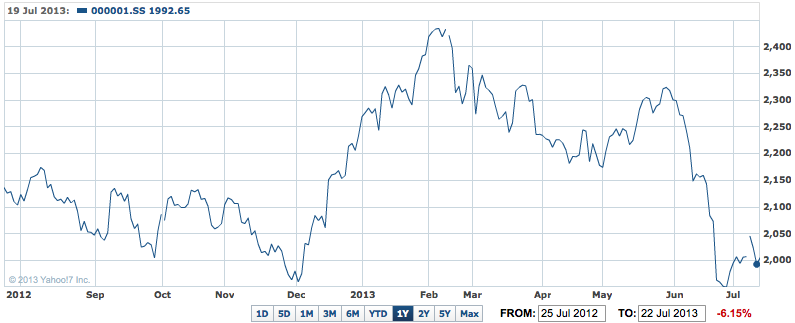Hours after the release of the so-called ‘flash‘ release of the monthly HSBC/Markit survey of Chinese manufacturing showing activity at an 11 month low, the country’s government has moved to provide limited stimulus, especially to small business.
The survey fell to an 11 month low of 47.7, from the final 48.2 for June (anything below 50 is a contraction), showing more weakness in export orders, orders generally and employment (which fell to a 52 month low).
The news saw Australian shares and the dollar fall (though not into negative territory) yesterday. The dollar was trading around 91.60 US cents this morning after it rose above 93 US cents after the release of the June quarter inflation figures yesterday.
The HSBC report followed soon after and the currency and the markets both fell sharply, as they always do on ‘bad news‘ from China. So will investors notice the move from the State Council last night?
HSBC chief China economist Hongbin Qu said in a statement with the survey that the preliminary result "adds more pressure on the labor market," adding that "the flash PMI reinforces the need to introduce additional fine-tuning measures to stabilize growth."
That’s what we got last night from the country’s State Council in a statement released Wednesday after an executive meeting of the State Council presided over by Premier Li Kegiang decided to suspend the value-added tax (VAT) and turnover tax on small businesses with monthly sales of less than 20,000 yuan ($US3,226) from August. 1. The move will benefit more than six million small companies and directly relate to tens of millions of people, the statement said.
The meeting also discussed measures to facilitate foreign trade and stabilize exports such as simplifying customs clearance, cutting operational fees, increasing financial support for profitable companies, facilitating exports of small and mid-sized private enterprises, increasing imports and maintaining a stable RMB exchange rate.
State Council said in its statement that China will fully open up its railway construction market through reforms and give priority to railway construction in the central and western regions as well as poor areas, according to the statement. That could be where some big dollar stimulus appears in the next few months. No dollar value was placed on the move – unlike a $US155 billion package of spending measures last year and the high $US486 billion at the end of 2008 after the GFC struck.
1Y – SSE Composite Index – China moves amid rising growth fears

Announcing the changes, the State Council said the economy was in reasonable shape but that it needed to push forward reforms to “stabilise growth”.
A day earlier the Council had revealed a ban on the construction of all new government buildings (including renovations) for the next five years.
The ban was the latest step in a campaign by President Xi Jinping, to rein in ostentatious spending by Communist party officials, a growing source of public unhappiness.
China’s economy has been slowing in 2013, with growth in the June quarter falling to an annual rate of 7.5%, from the 7.7% in the first quarter and 7.9% in the December quarter of 2012.
The government, which has set a full-year growth target of 7.5% this year, but had not yet stepped in to provide more stimulus measures to stop the slide.
Local markets in Australia of course ignored the news from Japan of further solid export growth (and the 12th monthly trade deficit in a row for our second biggest trading partner).
Japan’s Finance Ministry reported yesterday that exports rose 7.4% in June from the same month last year, while imports were up 11.8% after rising 10.1% in May (both figures are from the same month in 2012).
Analysts claimed the rise in the value of the yen in June clipped export growth, but did nothing to lower the value of imports.
This is a further sign that the 40% fall in the value of the yen is helping boost exports and is starting to lift industrial output and manufacturing activity.
Much of the import growth is down to the higher costs of energy imports to cover the closure of 50 of the country’s 52 nuclear power stations (due to the fall in the value of the yen).
On a geographic basis, exports to China rose 4.8% after May’s 8.3% rise, while those to the US grew 14.6%, down from the previous month’s 16.3% rise. Shipments to the EU countries swung back into gains, rising 8.6% in June after May’s 4.9% fall.
Over the six months to June, the data shows that the country’s export performance is clearly improving, with the growth in May and June well above the figures for the six month period. Exports to China, for example, fell 0.6% in the January – June period, but rose 8.3% and 4.8% in May and June respectively.
It was the same story for exports to Europe, the US and even Australia. In fact, in yen terms, imports from Australia in June were up 29.2%, but only 7.5% for the six month period.













